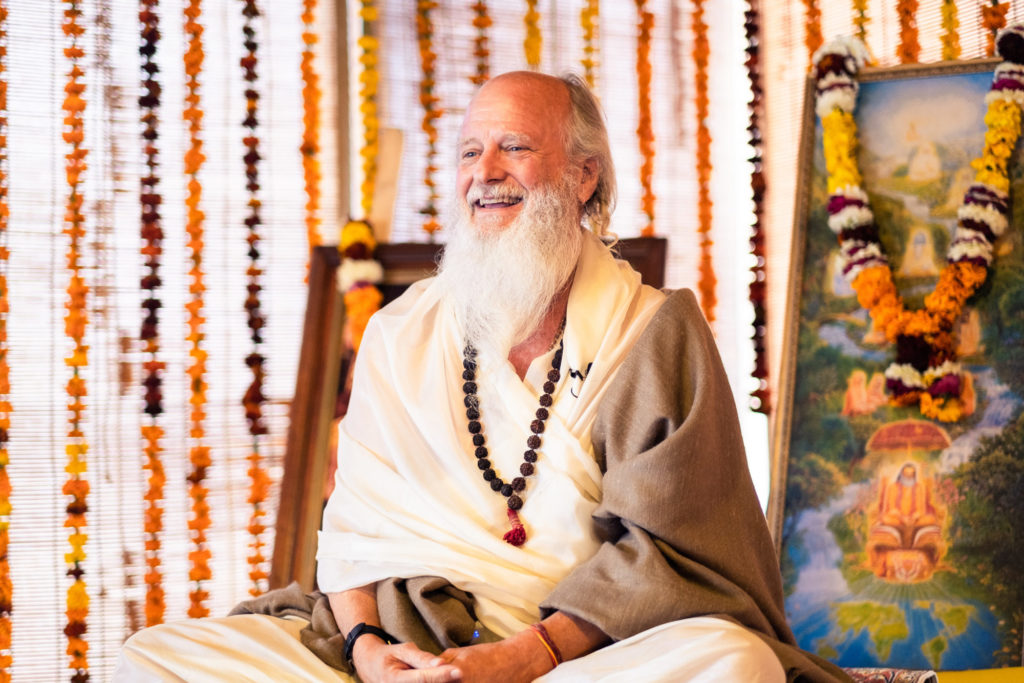“If Vedic Meditation uses a mantra, can’t I just make up my own meditation mantras and get the same results?”
This is a common question for those new to the Vedic tradition or anyone beginning their journey in learning Vedic Meditation or meditation teacher training. There are many types of meditation out there, each with its own ideas and techniques. You might even find a long list of mantras for meditation online or follow guided tracks that suggest simple meditation mantras for beginners.
It may seem easy to create your own mantra, but the truth is, the results will likely be very different from those you’d get with Vedic Meditation.
Vedic Meditation uses a specific kind of mantra, and holds a different perspective from any that recommend you choose your own mantra. To understand why Vedic Meditators don’t create their own mantra, let’s start with the kind of results you might get if you do create one for yourself.
The Limits of Choosing a Mantra
The ultimate goal of Vedic Meditation is to mature the meditator into the ideal version of themselves, or the version using their greatest potential and fulfilling their personal role in the evolution of everything. The Vedic Worldview holds that each person can either contribute to the evolution of all things to a greater consciousness state, or they can ignore the direction of nature and create ever more stress for themselves and others. It also maintains that an individual person cannot comprehend their greatest potential or role in the greater evolution of the Universe with their thinking mind.
So when a new meditator decides to make up a mantra or look for a list of mantras and their benefits, they will be selecting from the level of mind. Their selection of a mantra would be governed by questions like, “Who am I? “What should I be experiencing right now?” “What am I worried about?” What do I most want?”
Though these questions are natural, they will be colored by the stress the person has accumulated and the circumstances they find themselves in externally. The questions guiding their search for the right mantra would not be coming from the unified field of being, or consciousness itself. In a year, a week, or an hour, the answers to all of those questions (and even the questions themselves) could change.

Wishful Thinking Mantras
Consider the example of a child who believes their life will improve once they have a bicycle. They see their friends and older siblings with bicycles and feel frustrated when they can’t keep up. The child has witnessed adults meditating, so they decide to fixate on their desire for a bicycle.
In order to make the mantra, the child wants to know exactly what kind of bicycle they want. Is it a BMX bike or a beach cruiser? A bike with lots of gears, or the kind that is light and fast? Should it have a basket? A water bottle holder? A light? White wheels or black wheels? On and on. The child spends weeks finding the perfect bicycle to turn into their mantra.
Meanwhile, their neighbor drops a motorized scooter on the curb to throw away, now that their kids are too big for it. The child who wants the bike doesn’t notice the scooter, he’s still researching his bike. In a month, all the kids in the neighborhood have motor scooters instead of bikes, and he has neither a bike nor a motor scooter. How was he supposed to know that a bicycle would be irrelevant in just a few weeks?
Even if he were to get a bicycle with his special bicycle mantra, is that really going to fulfill his personal role in the evolution of everything?
Obviously this is an oversimplified example, but the point is to show that our limited minds rarely know what we most want, much less what would contribute to our evolution and the evolution of the entire cosmos.
The Mind and Fulfillment
The only way to interact and participate with our greater role in evolution and our movement toward happiness is to step beyond the limitations of thinking. To rely on the mind to navigate universality represents a juvenile, or not yet fully matured approach.
When a person is able to step beyond thinking and experience oneness with the unified field, they experience the source of thinking and Being, or the fountainhead of all the laws of nature. Those encounters bring about spiritual maturity, and they occur beyond thought.
That person who regularly encounters the field of Being in meditation would grow their inner sense of knowing what they are and how to put into action all of those talents and traits and capabilities in such a way as to fulfill their greatest purpose. They would become aware of what we call their dharma in Sanskrit, which leads to ultimate satisfaction.
The person who thinks of their own mantra would be meditating at the level of the mind, and though they may manifest changes in their life due to their constant thinking about one subject, they would not be able to move beyond thought into the field of Being.
The Student and the Goddess
After over fifty years of teaching nearly 50,000 students to meditate, Thom has seen all kinds of experiments in creating a ‘mantra’ (or rather, a wish-fulfilling thought). Thom recalls one student in particular:
“I remember one young man who came to me and said he wanted to have a mantra that was the name of a beautiful goddess. He wanted to close his eyes and draw the goddess unto himself. And he used the words ‘unto himself!’
I thought, this is a very dramatic 18 year old. It’s always lovely being 18. I loved it. I was doing my teacher training with Maharishi at the time. “To draw unto myself,” he said, “the beautiful goddess who, when she embraces me, will bring fulfillment to all of my Manliness and me a gentle hearted and happy individual. This is the kind of mantra I need. Can you teach me that mantra or help me find it?”
And I said, “What research have you done so far?” He said, “Well, I went through all of the Greek mythology and I decided to try out Artemis. Who the Romans called Diana. And then I went into the Babylonian and went into the Cretian goddesses…” So I asked him how long he had spent doing this research, and he said it had been about 9 or 10 months.
I said, “So you really think that if you draw the great goddess to yourself, this is going to allow you to live life to the fullest level of your being? In other words, you are exporting your power to meeting somebody outside of you – whether it’s in the spiritual or physical – that you yourself don’t have that capability? You want to export it to an object or person outside of you.” And he said, “Huh, I never thought of it that way.”
Let’s get used to stepping beyond that!

What kind of mantra leads to the field of Being?
Vedic Meditation uses only the Bija mantras, or those mantras from the Vedic tradition that have no intended meaning. Bija means ‘seed.’ These mantras are not wish-fulfilling devices. They are meaningless sounds with a particular vibratory quality or resonance that work on the mind in specific ways.
When a meditator repeats the right Bija mantra – one that has been assigned to them by a Vedic Meditation Initiator – the mantra will uniquely work with their mind to effortlessly move beyond thought.
Our job in Vedic Meditation is not to help you think of what you want or need or who you’d like to become. It’s not to re-invent the wheel by trying to create a vehicle for the mind to transcend thought, or guess what kind of thoughts will lead you to ultimate fulfillment. Rather than wasting years of research and trial and error, we rely on the mantras that have been used for thousands of years in the Vedic tradition.
The Ingredients of Meditation
The difference between finding your own mantra through trial and error or study and receiving a Bija Mantra from an ancient tradition can be compared to cooking.
Say you go to an authentic Indian restaurant and thoroughly enjoy the flavors of your meal. You’d like to re-create it at home. You could work from scratch and try to build the dish flavor by flavor. Without a recipe, you’d be trying to create a dish that someone else could make by instinct. The chef of the dish you tried has been eating and making this food their whole life, and the skills and ingredients and cooking style were passed down for generations.
You can gather all the ingredients and blend them in a blender, and it would not be the same dish. You could cook them hundreds of different ways with many different outcomes, and never re-create the dish.
Following the recipe passed down for generations is the only way to create the same experience. It’s the same with the mantra. You could spend time drawing from your knowledge and research to get any number of results, or you could rely on a 5,000 year old tradition with millions of meditators, and skip to the good part (the results!).
Spiritual Maturity
In the Vedic Worldview, spirit refers to your essence. It refers to you without thought, or the true self that arises when your mind is free from thinking, seeking, and stress. This worldview teaches that unless you’re experiencing spirit, or you without thought– unless you’re accessing the field of consciousness– you’re not developing yourself spiritually.
When you experience the field of being, you will naturally start to grow your spiritual maturity. You’ll transcend the petty ideas that if only this happened, or if only that happened, then everything in life would be fantastic. In truth, what you considered to be fulfillment in one particular epoch of your life might only one month later be considered a laughable goal that is no longer relevant.
With the recommended Vedic Meditation practice of twenty minutes twice each day, you can regularly immerse yourself in the field of Being. Learning to meditate with a Vedic Meditation Initiator will teach you how to step beyond thought. That way, you can steadily experience your essence and experience your personal role in the evolution of everything. You’ll receive a Bija Mantra, a specialized mantra for going beyond thought that can awaken your talent of becoming one with the source of all things.
Receiving a Mantra
When you take the Learn to Meditate course, you won’t see a list of mantras for meditation for beginners. The Bija Mantras have been passed down from teacher to student in an oral tradition for thousands of years. Meditators don’t share their mantra once they’ve received it, they keep it inside. Since each Bija mantra is personally assigned to each individual, it doesn’t work to pass them around.
The course consists of four days of training, with 90-minute sessions each day. In the course, you’ll receive a Bija Mantra that complements your vibratory state. Think about it like receiving a vitamin that will work with your body type and stage of life. The Bija Mantra is a vibration that is custom-suited to the bundle of vibrations that you are, so it can successfully charm your mind to a place of bliss without any effort on your part.
After the course, you’ll have a lifelong practice that you can use anytime, anywhere, without any tools or help. You’ll begin to meditate twice each day and experience a dissolution of your self (the small-s self that thinks and stresses and intellectualizes) and a dissolution of all of your stress. Your body will be able to release stress in the deeply restful states available in your practice. Many of those stresses cause you to desire things that are not actually helpful for you. The stress takes away from your true nature, and your meditation practice with the Bija Mantra will slowly uncover that true nature.
